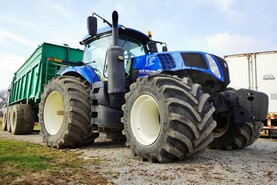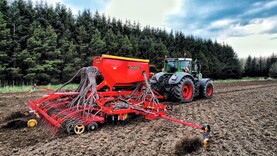Ten days ago, I was clapping myself on the back that we had got our remaining winter wheat and oats sown in good conditions and in advance of my cut-off date of 15 February. Now I am not so sure – land is saturated and the February-sown areas have pools of water where I have never seen water before and even the rows after the seed drill have a shiny, moist appearance. The crows and seagulls need constant monitoring and the corners which I would expect to have some compaction have much too much surface water. One of them had so much that I went closer and found the normally free-flowing water course full and almost static.
I followed it down stream and came to the bridge linking two fields over the stream submerged as the backed up water slopped over it. At this stage, we were looking at a growing expanse of water inundating my still-to-be-ploughed beans ground, as well as backing up on the still-to-emerge wheat.
I had bought the digger over 10 years ago, during the building collapse in the recession, and it has been worth its weight in gold ever since
The only option was to get my tracked digger to investigate.
I had bought the digger over 10 years ago, during the building collapse in the recession, and it has been worth its weight in gold ever since. I was reluctant to excavate out the bridge and carefully made mass concrete retaining walls with the concrete pipe running along the bottom of the ditch, so as a temporary measure we excavated out another channel to link up the stream on both sides of the bridge which had either a blocked pipe or else had collapsed.

Channel diverting stream following field bridge problems.
The water has now been gushing through the makeshift channel for 24 hours and while the level has dropped, it will take a while longer to see whether we need to rip up the existing bridge and pipe and replace the whole lot at significant cost or, whether we simply relieved a blockage that may have built up.
Meanwhile, every single animal is inside, even walking across the grassland is an effort. Turnout of stock even for grazing by day is so far away it’s impossible to fix even a target date.
The Continental bulls we are dribbling out are around 700-750kg
We have a huge contrast in stock in the sheds. The Continental bulls we are dribbling out are around 700-750kg, killing out at 56% – 61% with an R= grade, a disappointment. On the other hand, the dairy Hereford and Aberdeen Angus crosses that we bought in before Christmas look to me as if they will be lucky to make O=.
I am told I can expect them to kill out between 49-51% and the aim will be to get them to a 3+ or 4- fat score. The objective will be to get to this stage on grass and still be under 30 months. They are now about 550kg.
I hope to begin buying over the next few weeks
I was hoping for an early turnout to maximise weight gain and fat score by early July and to feed the absolute minimum amount of meal. Reading the Grange work on dairy beef, I am conscious of the absolute necessity of not overpaying for youngstock coming into the system. I hope to begin buying over the next few weeks and will then have a better idea if profits are possible from this new system.
Ten days ago, I was clapping myself on the back that we had got our remaining winter wheat and oats sown in good conditions and in advance of my cut-off date of 15 February. Now I am not so sure – land is saturated and the February-sown areas have pools of water where I have never seen water before and even the rows after the seed drill have a shiny, moist appearance. The crows and seagulls need constant monitoring and the corners which I would expect to have some compaction have much too much surface water. One of them had so much that I went closer and found the normally free-flowing water course full and almost static.
I followed it down stream and came to the bridge linking two fields over the stream submerged as the backed up water slopped over it. At this stage, we were looking at a growing expanse of water inundating my still-to-be-ploughed beans ground, as well as backing up on the still-to-emerge wheat.
I had bought the digger over 10 years ago, during the building collapse in the recession, and it has been worth its weight in gold ever since
The only option was to get my tracked digger to investigate.
I had bought the digger over 10 years ago, during the building collapse in the recession, and it has been worth its weight in gold ever since. I was reluctant to excavate out the bridge and carefully made mass concrete retaining walls with the concrete pipe running along the bottom of the ditch, so as a temporary measure we excavated out another channel to link up the stream on both sides of the bridge which had either a blocked pipe or else had collapsed.

Channel diverting stream following field bridge problems.
The water has now been gushing through the makeshift channel for 24 hours and while the level has dropped, it will take a while longer to see whether we need to rip up the existing bridge and pipe and replace the whole lot at significant cost or, whether we simply relieved a blockage that may have built up.
Meanwhile, every single animal is inside, even walking across the grassland is an effort. Turnout of stock even for grazing by day is so far away it’s impossible to fix even a target date.
The Continental bulls we are dribbling out are around 700-750kg
We have a huge contrast in stock in the sheds. The Continental bulls we are dribbling out are around 700-750kg, killing out at 56% – 61% with an R= grade, a disappointment. On the other hand, the dairy Hereford and Aberdeen Angus crosses that we bought in before Christmas look to me as if they will be lucky to make O=.
I am told I can expect them to kill out between 49-51% and the aim will be to get them to a 3+ or 4- fat score. The objective will be to get to this stage on grass and still be under 30 months. They are now about 550kg.
I hope to begin buying over the next few weeks
I was hoping for an early turnout to maximise weight gain and fat score by early July and to feed the absolute minimum amount of meal. Reading the Grange work on dairy beef, I am conscious of the absolute necessity of not overpaying for youngstock coming into the system. I hope to begin buying over the next few weeks and will then have a better idea if profits are possible from this new system.







 This is a subscriber-only article
This is a subscriber-only article









SHARING OPTIONS: